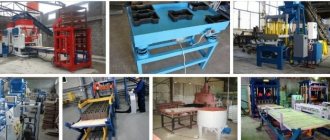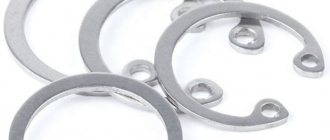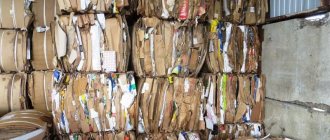One of the most popular equipment used in the waste recycling industry is a waste paper press. With its help, enterprises can easily process impressive volumes of paper waste, preparing it for further stages.
The equipment is a special machine. It compresses cardboard and paper products into convenient bales. This unit allows you to reduce the volume of waste up to 20 times, which makes it possible to save space in warehouses.
Differences between balers and compactors
Typical all-in-one compactor
Balers and compactors are often offered by equipment manufacturers as identical or similar products. However, even though they do similar work, their functions are slightly different.
The primary function of balers in industrial manufacturing is to compact and bind or “bale” recycled materials. The output is dense bales or briquettes. Compactors are also sometimes used to accumulate and compact recyclables, but they are primarily used to reduce the volume of waste removed. Despite these differences, you will often hear the terms "baler" and "compactor" used interchangeably.
Typical vertical baler with manual strapping
Just twenty years ago, only a few models of baling presses were presented on the domestic market. These were most often manual or mechanically driven presses. Nowadays the choice has become so wide that it confuses buyers.
The market is filled with domestic, European and Chinese presses. To make an informed purchasing decision, you just need to understand the features of these devices.
How the machine works
When figuring out what a mechanical press for waste paper is, you need to familiarize yourself with the operating principle of such devices. It consists in the fact that paper waste is compressed under the influence of impressive pressure in a special chamber.
The device can be used to process a wide range of materials, including:
- all types of paper products, including books, magazines, drawings and other products;
- packaging materials;
- boxes made from regular/corrugated cardboard;
- plastic container.
It should be noted that such equipment can be successfully used for processing other types of waste that are characterized by low density and strength. Compressed raw materials are much easier to store and transport, since they take up less space than uncompressed ones.
The use of devices of this type requires preliminary training of personnel in order to make the operation of the equipment as efficient as possible. In addition, waste paper presses are equipped with various safety and locking means to prevent emergency situations from occurring.
The devices have simple controls that make it easy to process impressive volumes of raw materials. Operation of the equipment is possible in various conditions, since it is able to function even at subzero temperatures. This can be achieved through the use of special lubricants.
Expert opinion
Alexandra Yu.
When thinking about environmental issues, it is important not only to sort, but also to reduce consumption.
To ensure long-term and uninterrupted operation of the units, maintenance is required at the intervals recommended by the manufacturer.
Selecting a baling press for its intended purpose
The baling press must compress rags, waste paper, plastic bottles and other recyclable materials. Bales should be tied fairly easily to prevent them from spilling. Finished bales should be easy to move and transport. Depending on the purpose, the baling press can be used for:
- saving space when accumulating recyclables;
- accumulation of a transport batch;
- formation of a wholesale batch;
- ease of transportation
- reduction of transport costs.
The most widespread use of a waste paper press is for the accumulation of recyclable materials and ease of transportation.
Chain supermarkets, shopping centers, markets, business centers, industrial enterprises - wherever recyclable materials are collected and accumulated, should evaluate the feasibility of using a baling press to accumulate cardboard and other recyclable materials (office paper, plastic film, etc.).
Technological capabilities of hydraulic presses
If you want to purchase a waste paper press in Moscow or other large cities, you need to study their key technical characteristics in more detail. The devices presented for sale differ from each other in several parameters, the most important of which are:
- chamber volume;
- equipment performance and drive power;
- pressing force;
- maximum density of processed raw materials;
- energy consumption level;
- dimensions;
- ease of transportation.
There are many varieties of such units. They may also differ in the type of installation and the drive used. Since all devices have their own characteristics, it is advisable to familiarize yourself with them in more detail.
Types of baling presses for recyclable materials
Baling presses vary:
- by type of construction
- by download type
- by piston force and pressure of the pressing plate
- according to the size of the working chamber
A typical baling press consists of a working chamber, a piston and a drive. Compressible recyclables are loaded into the working chamber. A piston controlled by a hydraulic cylinder or other mechanical drive compresses the material. The finished bale is then tied with twine or wire.
Baling presses differ in the direction of piston movement into:
- vertical
- horizontal
Vertical balers are available with one or two cylinders and one or more working chambers.
Horizontal presses, in turn, come with one or two pistons (located perpendicularly), as well as with manual or automatic binding. Sometimes imported horizontal presses are called “channel” presses.
For temporary work, there are mobile designs of small presses in the form of trailers for cars.
By type of drive, baling presses are divided into:
- manual
- electromechanical
- hydraulic
Manual Baler
The simplest design of a baling press is a screw one. The pressing plate moves vertically using a screw rod.
In addition to a screw drive, a lever (rack and pinion) drive can be used. This drive is more convenient for the operator.
This type of press is the cheapest, does not require electricity and practically does not break down. However, the productivity of such presses is low, requires a lot of manual labor, and the bale density is not high.
However, with the help of such a press you can obtain a small bale of waste paper or plastic film, which will be convenient to transport to your destination.
Electromechanical baling press
A more “advanced” type of baling press is electromechanical. Here the screw rod of the pressing plate moves with the help of a gearbox and an electric motor. Such a press will cost more than a manual one. For reliability and to avoid severe distortions of the pressing plate, guide rods are used.
An electromechanical press provides higher productivity and compression ratio than a manual one. The bales are denser.
Hydraulic Baling Press
A hydraulically driven press is a practical, productive and fairly reliable mechanism. It is more expensive than previous models, but it is the most popular type of baling press.
A hydraulic press can form a fairly dense bale of waste paper and other recyclables, because A hydraulic cylinder can develop much more force than a screw.
Baling presses with hydraulic drive are produced in a wide range of products. They differ in the size of the bale chamber, which affects the size of the bale formed. There is also a difference in the force of the press plate, which is usually expressed in tons or kilograms of force. The density of the bale depends on the force of the press and the area of the working plate.
How much pressure is needed to compact paper?
One of the most significant parameters of such units is the pressure force. Budget and low-power models are capable of demonstrating force from 2 to 10 tons, which is enough for processing paper, cardboard, and polyethylene.
If it is necessary to compress more durable materials, units with an indicator of up to 15 tons will be required. Pressing thin metal sheets can only be done with a force of about 30 tons. It should be noted that in the waste paper processing process, more powerful types of equipment can be used, which will allow for increased productivity.
Design features of the work plate
In addition, baling presses differ in the design features of the working plate. Firstly, there are differences in the number of working hydraulic cylinders. There may be two or one. Secondly, there may or may not be guide rods. The guide rods make the structure more rigid and prevent the work plate from skewing. Thirdly, the slab may have its own guides, usually at the corners.
To push out the finished bale, a chain is often used, which is attached to the working plate on the rise. Tippers with a separate hydraulic drive can also be used, but this is usually used in large balers where a bale in excess of 80 kg is formed.
Safety regulations
Although the press is a simple device to operate and use and does not require special skills to operate, at the same time it is a highly dangerous device.
It is necessary to start work responsibly and avoid negligence:
- Before starting work, the equipment is inspected for visible damage to the working mechanisms. During inspection, special attention must be paid to hydraulic cylinders and pipes. Make sure there are no leaks or spilled liquid.
- Make sure there are no foreign objects on the equipment.
- When working with a hydraulic press, you should carefully monitor the instrument readings. They should not exceed permissible limits.
- The work must be carried out in special clothing of the established type. You must wear gloves on your hands and your shoes must fit snugly on your feet.
- While the mechanism is operating, it is prohibited to adjust or add materials.
- When working, the technical requirements for the press must be met. Do not exceed the permissible load weight. Absence of materials not intended for compression by a press.
Following these simple rules will help you avoid injury and keep your equipment in working order.
A waste paper press is a useful thing in many industries. This is an invaluable aid in the warehouse business, storage and transportation. The press itself is a low-maintenance device and will quickly recoup the investment in it. The main thing is to choose the right press for your business. For those for whom purchasing new equipment is not suitable, we can advise you to buy a used waste paper press.
Types of waste paper presses (2 videos)
What influences the size of the working chamber of a baling press?
The size of the resulting bales of waste paper and other secondary raw materials depends on the size of the working chamber of the baling press. Naturally, the larger the bale, the heavier it is. Small bales can be carried by hand. Larger bales have to be turned or transported on carts.
Bales of “industrial” dimensions weigh about 200 kg and are moved using forklifts. These large bales fit comfortably on a semi-trailer or wagon and allow for a full load.
It is unreasonable to buy a large press for a small store and then have the whole team turn the resulting huge bales into a truck. Therefore, presses with a small working chamber are most often purchased. The bale weighs only 20-40 kg.
Typical baller sizes
Generally, the model or name of the bale will refer to the bale volume that the model produces. For example, 60-inch balers produce a bale that is 60 inches (wide). Of course, height and depth are the other two measurements needed to determine the actual size in cubic yards or feet. A 30-inch baler would most likely produce a bale volume that was close to 0.50 cu. yards or 13.5 cu. ft. For example, bale volume 30H X 30W X 24D = 21,600 cubic meters. inches, which is about half a cubic meter. tiers.
Typical vertical balers can vary in bale size, producing up to 80 wide or even higher. So if some base sizes are used on a Baler of that size (eg 40H X 80W X 40D), bale sizes can go up to 2.7 cubic yards or higher . By multiplying the three measurements it is easy to calculate the actual bale size.
When considering bales, it is important to try to determine the size of the PP so that workers or users do not have to do too much prep before putting the material into the baler (such as bendable cardboard). Therefore, before deciding on the size of bales, it is important to evaluate the typical size of items in the overall waste stream to be baled, combined with the hopper door opening and available space.
Additional space must be allocated to not only remove the bales, but also any maintenance requirements that may be required (typically about one mortar from the wall on the back and sides of the BCP). Also the ceiling height is very important, since the movement of the cylinder requires additional height beyond the normal "resting height" of the device.
Some of the other typical PCB sizes are:
- 42 l;
- 48 l;
- 60 l;
- 72 l;
- 84 liter PP.
There are also special pressings, such as:
- bales;
- foam;
- film PP;
- with core;
- PP of metal-cutting machines.
Working force of baling press
The greater the force, the denser the bale will be. But the main attention should be paid not to tons, but to the specific pressure of the pressing (working) plate, because it is the pressure that ensures the density of the bale. With the same piston force, more pressure will be created by a plate with a smaller area.
The force is especially important for forming bales of cardboard or plastic bottles, because... significant effort is required to compress them.
To protect the hydraulics, a pressure limiting relay or electronic control is used.
Waste classification
Let's see what common weights and measures are taken in waste treatment:
- 1 cube of space consists of 46,656 cubic meters. inches;
- 1 cu. a yard is equal to 27 cubic meters. feet;
- 1 bale (measured in cubic kernels) = LXWXH (in inches) divided by 46,656;
- 1 Bale (measured in cubic Ft) = LXWXH (in inches) divided by 46,656 X 27;
- 1 bale measuring 36L X 36W X 36H equals 1 cubic yard.
Lost balance sheets
Typical bulk densities and other characteristics of waste streams vary from industry to industry and from location to location within an industry. It makes sense that waste streams or waste profiles with the highest air content benefit the most from compaction. Since debris profiles can vary significantly within the same industry (and even within the same market segment), the strength of compaction or benefits derived from Balers will also vary accordingly.
Unallocated or non-compact
Bulk or oil-free materials require a huge amount of space compared to a dump. One of the main benefits of baling as much recycling waste (such as bulky cardboard) as possible is that materials are removed from the waste stream. Even when there is no recycling program, this can significantly reduce waste transportation requirements since even small amounts of packaged waste are likely to be loaded free of charge by the recycler.
Occupational safety when working with a press
A hydraulic press is a dangerous machine.
If handled improperly, the press can damage your hands. A good baling press is equipped with sensors and switches that do not allow the press to be turned on when the working chamber is open. Many models have two start buttons to keep the operator's hands out of the work area.











